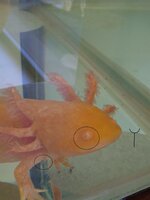Update for anyone struggling with anchor worms (Australia).
I ordered dimilin powder online from eBay and treated for a few weeks. It has cleared up the problem and he is very happy now. I did try a product called paracide by blue planet while I waited for the powder to arrive (had to order from overseas as it is a banned substance in Australia and I was worried it might not be cleared by customs) - it helped but didn't fully eradicate the annoying anchor worms even after four weeks of treatments. I suppose if I had done it for even longer it may have worked, but the dimilin powder came in the post by then. The paracide tablets did not hurt the axolotls, they seemed happy and ate perfectly fine (that is just my own experience).
I did do a few other things to help speed up the process and guarantee success. Weekly water changes as per treatment (I did about 50 percent the first two weeks and then 30 percent for the rest of the weeks). Each time I would take out the plants and give them a thorough wash. I also have a chiller for Summer which I set at a lower temp than usual (17 degrees) - helps to keep the axolotl calm and anchor worms do not like the cold as per my research. Cold water stops the baby worms/crustaceans from properly forming and female anchor worms are less likely to breed/release eggs at low temps.
The final thing I did to ensure they would not come back is to treat for four weeks or even longer. Two weeks isn't enough even though the bottle will say it is. This is because the medication often does not kill adult anchor worms unless they are molting. Which means that the females (which are harder to kill) often continue laying their eggs and you have the problem all over again. The trick is to break the cycle. Female anchor worms have a life span of about 30 days, so if you treat for four weeks or longer, this will ensure you kill off the eggs and the female will eventually just die of old age.
Final thoughts/advice:
1) just find a way to get a hold of dimilin powder. It works the best. If you can't - find an alternative that is safe for axolotls as they are sensitive creatures.
2) treating for longer than four weeks leads to higher success of eradication. You do not want these suckers back!
3) colder temperature is prefered because anchor worms do not do well in it. I heard some people fridge their axolotls, but whenever I do this, my axolotls hate it! Apparently, really low temps (fridge temps) can kill the adults, but don't quote me on that.
4) make sure to treat original tank and quarantine tank, otherwise you get reinfestation.
5) purchase your pets from reputable aquariums or a store that actually knows how to look after these exotic pets. You end with a healthier axolotl and better advice. I won't be going back to the aquarium I got mine from since that's where the anchor worms came from (or from the breeder they use).
6) Do your research! I struggled finding help on anchor worms, particularly with which medications is available in Australia. Learning about the lifecycle of anchor worms also helps.
7) quarantine any live plants or aquatic pets before introducing them into the tank.
That's it from me. Please know that what I have written above is from my own personal experience of how I got rid of anchor worms for axolotls based on my own research.
I hope this helps anyone struggling. You do have to put time and energy into treating the tanks. It is a commitment to eradicate anchor worms, but keeping axolotls are a commitment regardless. The easiest way to deal with anchor worms is by not having them at all, so prevention is key.



